DEEP Halts Work on Trout Brook Flood Control Project Amid Protests

Audio By Carbonatix
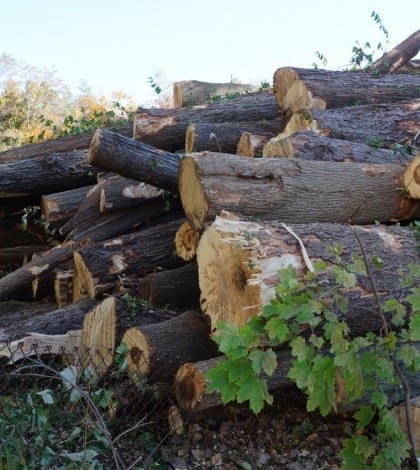
The scene at the end of Linbrook Road Friday afternoon, Oct. 23. Photo credit: Ronni Newton
West Hartford officials and residents have now gotten the attention of DEEP regarding clearcutting and other actions taken as part of the flood control system along the South Branch of the Park River.
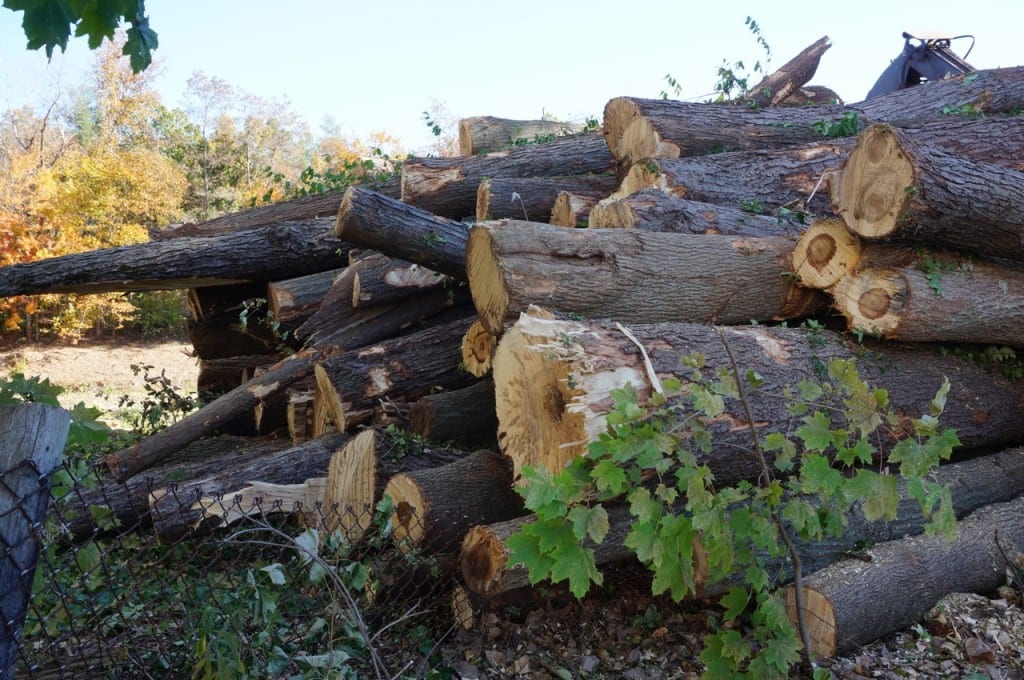
The scene at the end of Linbrook Road Friday afternoon, Oct. 23. Photo credit: Ronni Newton
By Ronni Newton
Although some residents may believe the action is “too little and too late” after clearcutting took place at the end of Linbrook Road last week, the Department of Energy and Environmental Protection (DEEP) is now showing some willingness to listen to public opinion regarding a major flood control project that impacts the landscape of West Hartford and other surrounding communities.
Residents and officials will have a chance for dialogue with DEEP Commissioner Robert Klee, who along with other agency officials plans to attend the West Hartford Town Council meeting on Tuesday, Oct. 27, at 7:30 p.m. in Town Hall Room 314. The meeting is open to the public.
DEEP Communications Director Dennis Schain issued a press release Monday, indicating that the agency is now “taking a series of steps aimed at addressing concerns of residents about maintenance work on the flood control system along the South Branch of the Park River.”
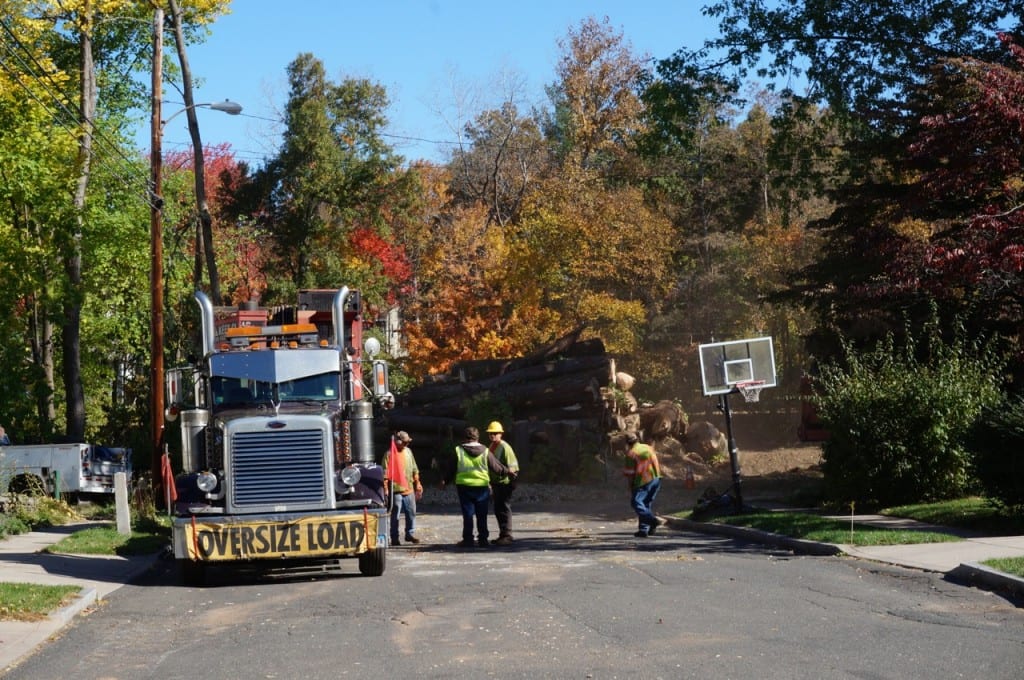
DEEP contractors haul away the remnants of trees that were cleared from the land at the end of Linbrook Road on Oct. 23. Photo credit: Ronni Newton
Those steps include issuing a two-week stop order to work being done by DEEP contractors on the flood control project. During that period, the contractor “will only engage in activities determined to be minor and non-impactful and will not undertake any actions that could affect natural resources or homeowners in any significant way,” the release stated.
In addition, DEEP has scheduled a Public Information Session in West Hartford on Nov. 4, at 6:30 p.m. in the Town Council chambers at West Hartford Town Hall. According to Schain, there will be a presentation about the project and residents will be able to speak with DEEP staff about it.
West Hartford Mayor Scott Slifka said that Town Council meeting rules will be suspended to allow for Tuesday night’s discussion since it was not originally on the agenda. “This is an extraordinary and serious situation,” Slifka said.
Before he learned of DEEP’s decision to meet with the Council and residents on Monday, Slifka had said he was “disgusted” with the agency and extremely frustrated with what he called “the epitome of a lack of outreach.”
Prior to learning of the DEEP’s efforts to open up communication channels, residents of Linbrook and Linnard Roads – the “Horseshoe Neighborhood” – had planned a meeting Monday night to discuss their concerns about what they call the devastation in their neighborhood. The meeting still took place, and the approximately 40 residents in attendance used the time to determine what they will discuss with DEEP on Tuesday evening at the Town Council meeting.
Slifka, Deputy Mayor Shari Cantor, and Council members Chris Barnes and Leon Davidoff, all of whom were uninformed about the scope of the project until it actually commenced last week, also attended the meeting.
Although the land that has been impacted is owned by the state, and this is a state and federal project, Slifka said there should have been some ability to negotiate in advance even though it’s out of the town’s jurisdiction.
“Our frustration is that DEEP didn’t take our suggestions about advance outreach,” Cantor said, referring to a letter written by Town Manager Ron Van Winkle to the DEEP in July when he first reviewed the project plans. Those plans, which can be viewed by clicking here, did not indicate clearcutting at the end of Linbrook.
“What we try to do is exercise our bully pulpit. Now we’re left to clean up the mess,” Slifka said.
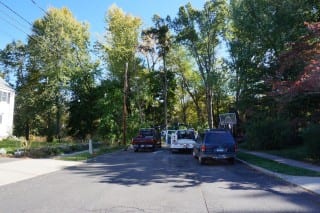
The dead end of Linbrook Road on Monday, Oct. 19, as DEEP contractors were beginning work. Photo credit: Ronni Newton
“It was devastated. Every tree was down with the exception of two trees – one that was dead and one silver maple that is weaker,” Linnard Road resident Wendy Fair said of the clearcutting that took place at the end of last week.
The clearing took place on Wednesday, Thursday, and Friday of last week. The work was done after a two-day hiatus that was promised after an impromptu meeting between the DEEP project manager, the contractor, and West Hartford Public Works Director John Phillips took place on the site on Monday, Oct. 22. Following that meeting, residents had also been promised a 20-foot (rather than the originally planned two-foot) buffer between property lines and the project work area. Project Manager Dan Biron had also agreed to keep some of the larger oak trees.
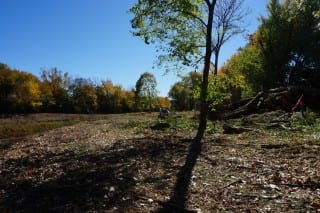
Area at the end of Linbrook along Trout Brook, after most trees had been cleared on Friday, Oct. 23. Photo credit: Ronni Newton
Fair said that her husband, Dick Fair, had been told that a certain “symbolic” oak tree would be preserved. “It was gone Thursday. All of the oaks were gone,” Fair said.
When asked specifically about the buffer and the request to preserve certain trees, Schain said in an email that the 20-foot buffer “was left and exists as was negotiated with residents. That stretch of about 20 feet is there. There was one other tree – up close to the water (that was not really a very healthy tree) and not in 20 foot buffer – that we said we would try and keep but that did inadvertently come down.” Schain did not know if that was the specific oak tree that was supposed to have been kept.
Since the trees are now gone, residents’ concerns center on what will happen to the land after the flood control project has been completed.
“The reason there was such an uprisal is that we were not informed, except that some received a letter about vegetation,” Fair said. Fair, who lives at the dead end of Linnard Road where a large swath of trees was also removed, said that she didn’t even get the letter about vegetation. “It just said there would be maintenance work in the area. Nothing that was alarming,” she said.
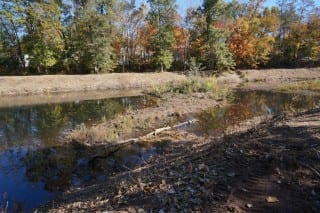
Sediment that has built up in Trout Brook impedes its use in flood control. Photo credit: Ronni Newton
Most residents of the impacted area agree that the goal of keeping the waterway clear as part of a flood control management plan that has existed for decades is good. They don’t want the area’s flood control plan to be decertified, which could result in more residents needing to purchase expensive flood insurance.
“The maintenance work on the flood control system along the South Branch of the Park River is critical to protecting lives and property as these waters flow through West Hartford, Newington, and Hartford,” said DEEP Commissioner Robert Klee in Monday’s news release. “We need to complete this project to ensure that it remains in compliance with federal requirements and continues to provide the protection people have come to rely upon – and to do so in a manner, that as much as possible, addresses issues that have been raised by people who live nearby.”
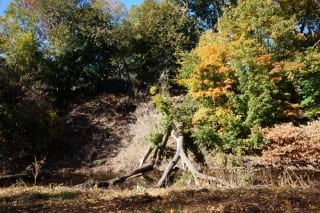
Large trees like this one that has fallen across Trout Brook south of Fern Street can cause a problem in the event of a flood, Dir. of Public Works John Phillips said. Photo credit: RonnI Newton
Area residents are concerned that their voices be heard, and that West Hartford officials are able to be kept in the loop about future work by the DEEP as well as a major sewer project that the MDC will soon begin in the same neighborhood.
“How do we end up with something now that we can work with? We should have known the scope of this project. How do we go forward?” Fair asked.
Director of Public Works John Phillips said he will plan to work closely with the DEEP on a replanting plan for the area. “They need to plant new trees strategically, out of the way of the maintenance and flood channel,” Phillips said Friday on a tour of Trout Brook where he pointed out potential problems with trees falling into the brook and obstructing the flow. “We’ll work hard to have the maximum caliber of tree, not saplings, planted to create impact,” Phillips said.
Those are some of the questions, and concerns, that residents will likely want DEEP to address Tuesday night. Residents and town officials will also want the DEEP to explain and communicate the process planned for removing and dewatering the sediment in Trout Brook, contaminent testing, and traffic management in the area.
Like what you see here? Click here to subscribe to We-Ha’s newsletter so you’ll always be in the know about what’s happening in West Hartford!




[…] DEEP Halts Work on Trout Brook Flood Control Project Amid Protests […]
[…] DEEP Halts Work on Trout Brook Flood Control Project Amid Protests […]
[…] and I apologized last week for the lack of outreach. That was really dropping the ball on our part. We did stop work for two weeks so we could make a fresh start, and other than one rogue subcontractor [that violated the stop-work order and was let go] … […]